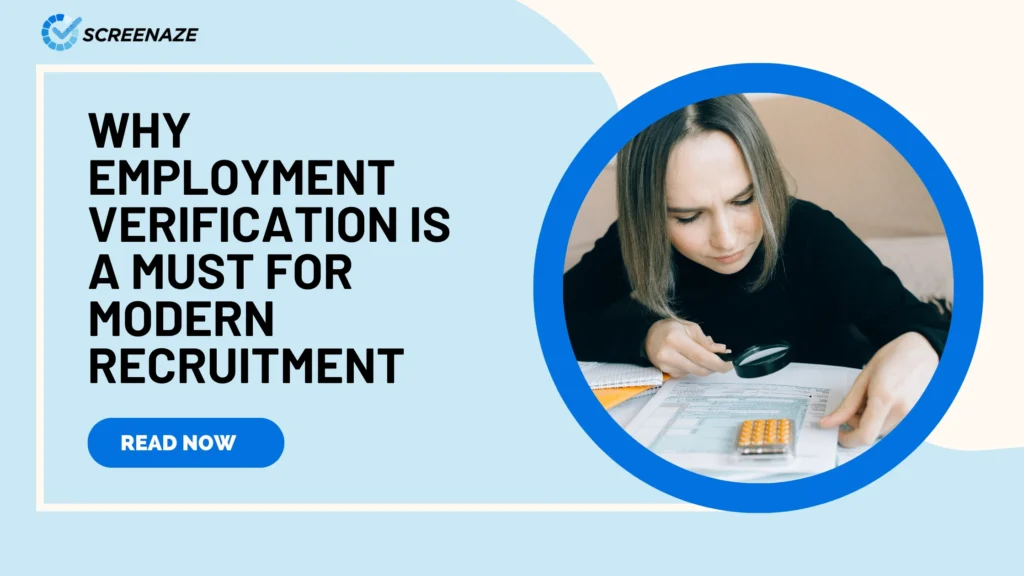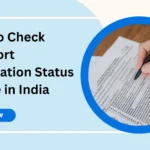The recruitment landscape has changed dramatically in recent years. With the rise of remote hiring, increasing competition for skilled professionals, and growing pressure on HR teams to hire quickly, the risk of overlooking candidate authenticity has never been higher. Today, many applicants exaggerate their experience, falsify job titles, or even provide completely fabricated employment histories in order to secure positions. For businesses, such hires can lead to financial loss, reduced productivity, and long-term damage to reputation.
This is where employment verification becomes a vital tool in modern recruitment. By verifying a candidate’s past employment details—including tenure, roles, responsibilities, and overall track record—employers can make more informed decisions and avoid costly hiring mistakes. Employment verification not only ensures accuracy and compliance but also builds trust between employers and employees from the very beginning. In an era where transparency and reliability are critical, employment verification is no longer optional—it’s a must-have step for any organization committed to safe and effective hiring.
Table of Contents
What is Employment Verification?
Employment verification is the process of confirming a candidate’s work history, including their past job titles, responsibilities, dates of employment, and sometimes even reasons for leaving. It is one of the most important steps in the hiring process, helping organizations validate the accuracy of information provided on a resume or job application. With workplace fraud and resume manipulation becoming increasingly common, employment verification ensures that employers can trust the information they rely on to make critical hiring decisions.
At its core, employment verification acts as a safeguard. Candidates may exaggerate their roles, inflate their experience, or list fake companies in an attempt to appear more qualified. Without verification, businesses risk bringing in individuals who may lack the skills or integrity to perform effectively. This can lead to wasted resources, compliance issues, and a negative impact on workplace culture.
The process of employment verification typically begins with the candidate’s consent, followed by cross-checking their work history with former employers, HR departments, or third-party verification services. Employers verify details such as:
- Job titles held
- Dates of employment (start and end)
- Duties and responsibilities performed
- Rehire eligibility or reasons for leaving (when available)
For highly regulated industries like finance, healthcare, or IT, employment verification is even more crucial. Companies in these sectors must meet strict compliance standards, and hiring an unqualified or dishonest employee could lead to legal penalties. Even outside regulated industries, accurate employment records help HR teams build a reliable workforce and prevent disruptions caused by unsuitable hires.
Employment verification differs from general background checks. While background checks may cover criminal history, education, or identity verification, employment verification is specifically focused on confirming professional experience. Together, these checks provide a complete picture of a candidate’s suitability for a role.
Modern recruitment demands transparency and trust, and employment verification delivers exactly that. By confirming the truth behind a candidate’s resume, businesses gain confidence in their hiring decisions, reduce risks of fraud, and ensure a safer and more productive workplace.
Common Issues in Recruitment Without Verification
Hiring the right candidate is one of the most important responsibilities for any business. However, without a proper employment verification process, companies expose themselves to significant risks. Many candidates may look impressive on paper, but resumes and job applications are not always accurate. Below are some of the most common issues organizations face when recruitment is done without verification:
1. Fake or Exaggerated Resumes
A growing challenge in modern recruitment is the submission of falsified resumes. Candidates may exaggerate job titles, inflate responsibilities, or extend employment dates to cover gaps. Without verifying this information, HR teams may hire someone who lacks the real skills or experience needed for the role.
2. Unqualified Hires
When candidates misrepresent their professional background, businesses may end up employing individuals who are not truly capable of handling the position. This can directly affect productivity, team performance, and overall business efficiency.
3. Fraud and Misconduct Risks
Hiring someone without checking their past can lead to potential fraud or misconduct. A person who has been terminated from a previous role due to unethical behavior may repeat the same actions in a new workplace, causing financial or reputational harm.
4. Compliance Issues
In regulated industries such as finance, IT, or healthcare, compliance is a major concern. Employing individuals without proper verification may result in violations of legal or industry standards, leading to fines, lawsuits, or loss of licenses.
5. High Turnover Rates
Employees hired without proper vetting are more likely to leave prematurely, either because they cannot perform the role effectively or because their misrepresentation is eventually discovered. This leads to higher turnover, wasted recruitment costs, and additional time spent rehiring.
6. Damage to Company Reputation
One wrong hire can do more than harm internal operations—it can also damage customer trust. If a client learns that your company employed someone dishonest or unqualified, it could impact long-term business relationships.
7. Workplace Disruption
Unverified hires can create conflict within teams. Colleagues may feel frustrated when they realize a team member is unskilled or unfit for the role, which affects morale and workplace culture.
Benefits of Employment Verification
In today’s competitive job market, businesses cannot afford to rely solely on resumes and interviews when making hiring decisions. Employment verification offers a structured way to confirm the truth behind a candidate’s professional claims, reducing risks and ensuring better recruitment outcomes. Below are the key benefits of incorporating employment verification into the hiring process:
1. Ensures Accuracy of Candidate Information
One of the primary benefits of employment verification is confirming the details a candidate provides. Many job seekers unintentionally or intentionally exaggerate their experience, stretch employment dates, or inflate job responsibilities. By conducting verification, employers gain confidence that the candidate’s history is genuine and matches what is required for the role.
2. Protects Against Fraud and Misrepresentation
Hiring an employee based on false credentials can lead to serious consequences. Fraudulent hires may misuse company resources, compromise sensitive information, or damage trust within the organization. Employment verification helps detect false claims early in the hiring process, preventing businesses from onboarding individuals who may pose risks.
3. Enhances Compliance with Industry Standards
Certain industries, such as finance, healthcare, IT, and government, are heavily regulated. Employers in these sectors must demonstrate due diligence in verifying employee credentials. Employment verification ensures businesses meet compliance requirements, avoid legal penalties, and maintain licenses or certifications necessary for operation.
4. Improves Quality of Hiring Decisions
Recruitment decisions directly impact business performance. A well-verified employee is more likely to have the skills, integrity, and experience necessary to succeed in their role. Employment verification helps HR teams focus on candidates who are genuinely qualified, improving the overall quality of hires and reducing hiring risks.
5. Reduces Employee Turnover
A bad hire not only affects productivity but also increases turnover costs. Employees who misrepresent their work experience may struggle to meet expectations, leading to frustration for both themselves and their employers. Verification helps ensure candidates are fit for the role, reducing the likelihood of premature exits and saving the company significant rehiring expenses.
6. Builds Workplace Trust and Safety
Workplace culture thrives on trust. When every employee goes through employment verification, it reassures teams that their colleagues are qualified and honest. This helps maintain harmony, reduces workplace conflicts, and fosters a culture of reliability and accountability.
7. Protects Company Reputation
Reputation is one of the most valuable assets for any organization. Hiring an unverified or dishonest employee can harm relationships with clients, partners, and stakeholders. Employment verification ensures businesses maintain credibility by employing individuals who meet the highest standards of professionalism.
8. Saves Time and Resources in the Long Run
While verification requires time upfront, it ultimately saves businesses significant costs by reducing turnover, minimizing compliance risks, and avoiding disruptions caused by unqualified hires. Investing in verification today prevents costly mistakes tomorrow.
9. Supports Remote and Global Hiring
With remote and international recruitment becoming more common, verifying employment history is essential. Employment verification helps confirm global work experience and ensures candidates from different regions meet local compliance and industry standards.
How Employment Verification Works (Step-by-Step)
Employment verification is a structured process that helps employers validate a candidate’s work history before making a hiring decision. While it may seem complex, the process can be broken down into clear and manageable steps. Here’s how it typically works:
Step 1: Candidate Consent and Documentation
The process begins with the candidate’s consent. Employers must obtain written or digital permission from the applicant to verify their past employment records. Along with consent, candidates provide essential documents such as resumes, reference contacts, offer letters, or relieving letters. This ensures transparency and compliance with data privacy regulations.
Step 2: Collection of Employment Details
Once consent is secured, HR teams or background verification agencies collect information regarding the candidate’s previous employers. This includes:
- Company names and locations
- Designations held
- Dates of employment
- Key responsibilities and achievements
- Reporting managers or HR contacts
This step forms the basis of the verification process.
Step 3: Contacting Previous Employers
Verification experts reach out to the candidate’s former employers, HR departments, or supervisors to validate the information provided. In some cases, direct access to centralized employment databases may also be used. The communication focuses on confirming factual details like tenure, role, and performance history.
Step 4: Cross-Checking Documentation
Supporting documents, such as offer letters, appointment letters, or salary slips, are compared against the responses from previous employers. This step ensures consistency between what the candidate has submitted and what is confirmed by the organization. Any mismatch is flagged for review.
Step 5: Identifying Employment Gaps
The verification process also highlights unexplained gaps in a candidate’s employment history. Employers can then seek clarification directly from the candidate. While short gaps may be valid, longer unexplained periods could raise red flags.
Step 6: Validating Roles and Responsibilities
It’s not enough to just verify titles and dates. Employment verification digs deeper to confirm the candidate’s actual responsibilities and contributions in each role. This helps employers assess whether the candidate has genuine experience relevant to the new position.
Step 7: Compliance and Eligibility Check
In regulated industries, additional checks are carried out to ensure the candidate meets legal and compliance standards. For instance, a candidate applying for a finance role may be screened for eligibility to work in sensitive financial environments.
Step 8: Report Compilation
After all checks are completed, the findings are compiled into a detailed verification report. This report highlights:
- Confirmed employment history
- Any discrepancies found
- Overall credibility of the candidate’s work record
Employers use this report to make informed hiring decisions.
Step 9: Employer Decision-Making
Finally, HR teams review the report to decide whether the candidate is suitable for the role. Verified candidates move forward in the hiring process with confidence, while those with major discrepancies may be reconsidered or disqualified.
What is Employment Verification?
Employment verification is the process of confirming a candidate’s past and current work history to ensure the accuracy of the information provided during recruitment. It is one of the most critical steps in background screening, helping employers make informed hiring decisions while reducing the risks associated with fraudulent or exaggerated resumes.
At its core, employment verification involves checking details such as job titles, dates of employment, responsibilities, and reasons for leaving a previous role. By reaching out to past employers or using professional verification services, businesses can validate whether the candidate truly has the experience and skills they claim.
This process is vital because hiring decisions significantly impact an organization’s growth, culture, and reputation. A wrong hire can lead to financial losses, lower productivity, and even compliance issues. Employment verification ensures that candidates have the qualifications necessary to perform the job effectively and ethically.
Key Elements of Employment Verification
- Job Title & Position – Confirms the role the candidate held.
- Dates of Employment – Verifies start and end dates to identify any employment gaps.
- Roles & Responsibilities – Ensures candidates possess relevant experience for the position.
- Reason for Leaving – Provides insights into the candidate’s career progression and stability.
- Employer Reputation – Validates whether the listed company is legitimate.
Why is it Important?
In today’s competitive job market, resume fraud has become increasingly common. Candidates may exaggerate skills, inflate titles, or even falsify employment history. Employment verification protects organizations from these risks by offering transparency and truth.
For industries like finance, healthcare, IT, and law, where trust and compliance are paramount, verifying employment history is not just a best practice but often a regulatory requirement. Employers who skip this step may face legal complications, loss of credibility, or higher employee turnover.
Benefits for Employers
- Better Hiring Decisions – Employers can choose candidates based on verified, reliable information.
- Reduced Risk of Fraud – Protects businesses from dishonest applicants.
- Enhanced Workplace Safety – Ensures employees meet professional and ethical standards.
- Regulatory Compliance – Helps organizations meet legal and industry-specific standards.
The Role of Professional Verification Services
While some companies perform employment checks internally, many prefer professional verification providers like Screenaze. These services streamline the process, ensure faster turnaround times, and provide more accurate results. By partnering with experts, businesses can focus on core operations while maintaining peace of mind about the integrity of their workforce.
How Screenaze Simplifies Employment Verification
In today’s fast-paced job market, hiring the right candidate is more important than ever. Employers need to ensure that the information presented on a candidate’s resume is accurate, complete, and truthful. Employment verification plays a key role in this process, but it can often be time-consuming and complicated for businesses to handle on their own. This is where Screenaze steps in, providing a streamlined, efficient, and reliable solution to simplify employment verification for companies of all sizes.
Why Employment Verification Matters
Before diving into how Screenaze helps, it’s important to understand why employment verification is so crucial. Many candidates exaggerate their skills, job titles, or even employment dates to gain an advantage during recruitment. Without proper verification, businesses risk hiring individuals who may lack the required expertise or integrity. This can lead to higher turnover, compliance issues, and even reputational damage.
Employment verification ensures employers can:
- Confirm work history and job roles.
- Validate dates of employment.
- Understand reasons for leaving past positions.
- Reduce the chances of resume fraud.
- Make informed and confident hiring decisions.
How Screenaze Makes the Process Easy
Screenaze understands the challenges businesses face when it comes to background screening and verification. To address these, it offers a simplified, technology-driven approach that saves time and delivers accurate results.
1. Automated Verification Tools
Screenaze uses advanced systems to connect with databases and trusted sources, reducing manual effort. This ensures that information is verified quickly without the delays that come with traditional methods.
2. Comprehensive Checks
From confirming job titles and roles to validating employment dates and responsibilities, Screenaze provides a complete picture of a candidate’s work history. This helps employers make more informed choices.
3. Fast Turnaround Time
Time is critical in recruitment. Delays in verification can slow down the hiring process and cause companies to lose top talent. Screenaze ensures faster processing, enabling businesses to hire confidently without unnecessary waiting periods.
4. Accurate and Reliable Results
Accuracy is at the heart of employment verification. Screenaze ensures that every detail is cross-checked against reliable sources so that employers receive trustworthy information about potential hires.
5. Customizable Solutions
Every business has unique needs. Screenaze offers flexible packages and tailored solutions so organizations can choose the level of verification that fits their industry and compliance requirements.
6. Secure and Confidential
Handling sensitive employee information requires high levels of security. Screenaze maintains strict data protection protocols, ensuring all candidate information remains private and protected.
Benefits of Using Screenaze for Employment Verification
By partnering with Screenaze, businesses enjoy several advantages:
- Reduced Risk of Fraud: Employers gain confidence knowing candidate information has been thoroughly verified.
- Faster Hiring Decisions: The hiring process becomes smoother and more efficient.
- Improved Compliance: Screenaze helps organizations meet regulatory standards across industries.
- Peace of Mind: Businesses can focus on growth, knowing they are hiring the right talent.
Conclusion
Employment verification no longer has to be a stressful or time-consuming process. With Screenaze, businesses gain access to automated tools, accurate data, and tailored solutions that simplify recruitment from start to finish. By ensuring that candidates are truthful about their experience and qualifications, Screenaze helps organizations build a trustworthy, capable workforce.
In an era where hiring mistakes can be costly, Screenaze provides the peace of mind every employer needs—making employment verification faster, smarter, and more reliable than ever before.





